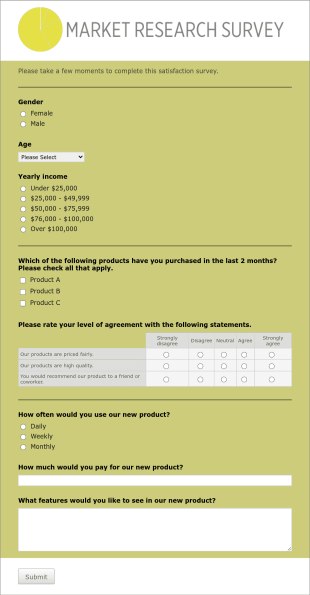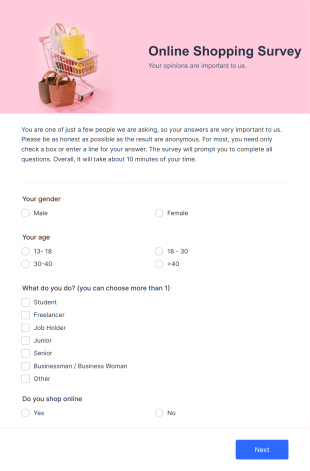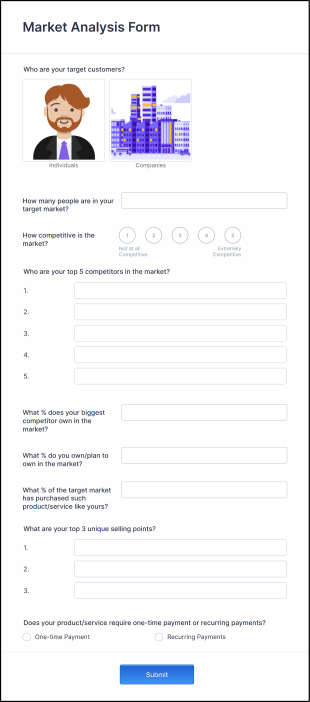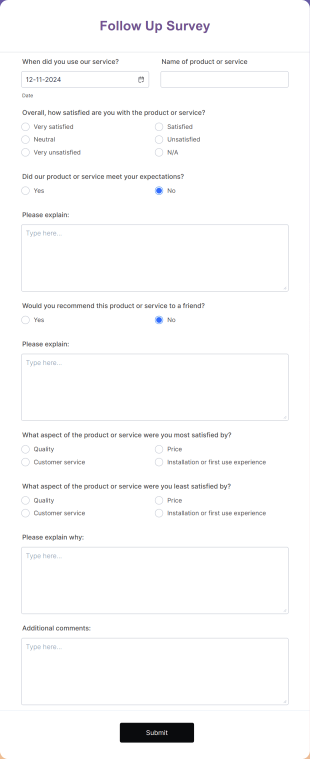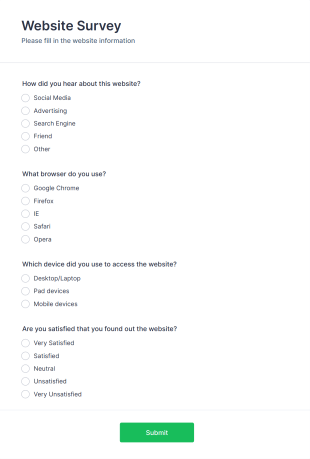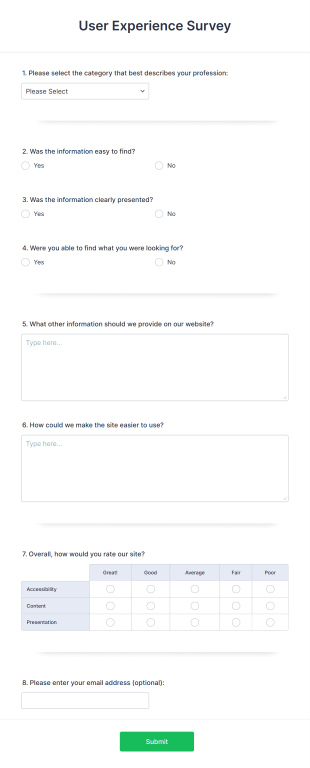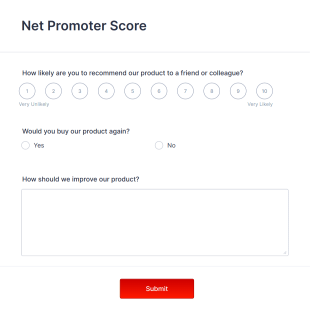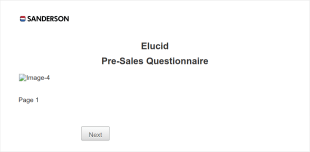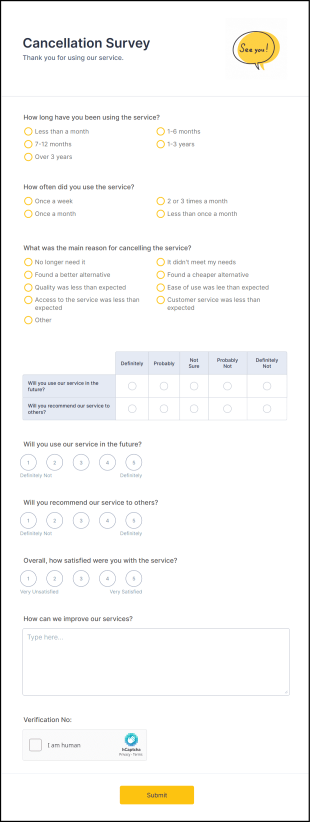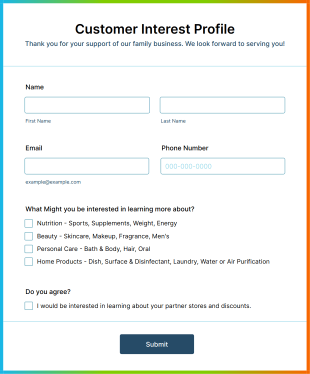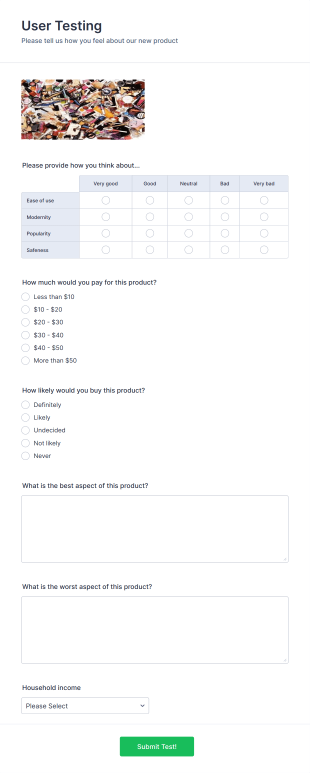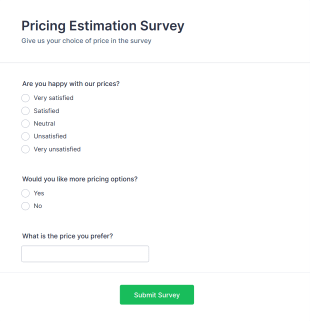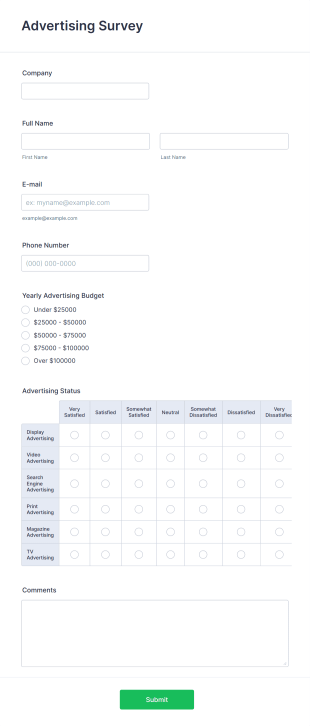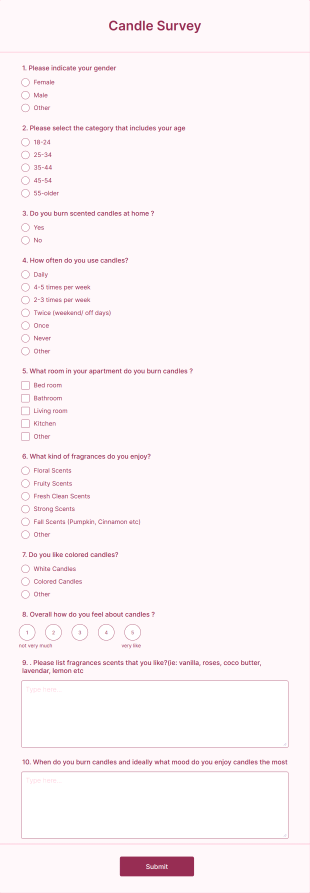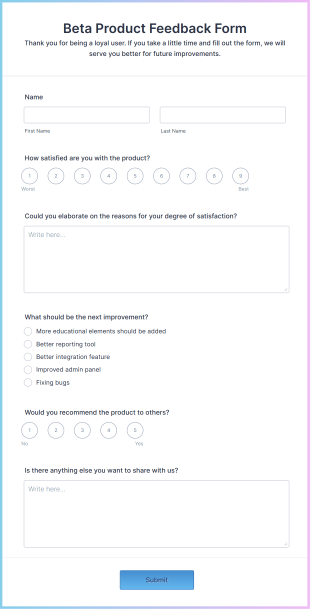Marketing Survey Templates
About Marketing Surveys
Marketing Survey Templates are pre-designed forms specifically created to help businesses, agencies, and organizations gather valuable insights about their target audience, brand perception, product feedback, and overall market trends. These templates are used to collect data on customer satisfaction, campaign effectiveness, brand awareness, product launches, and more. Whether you’re conducting market research, measuring customer loyalty, or testing new concepts, marketing survey templates streamline the process of designing and distributing surveys, ensuring you capture the information you need to make informed decisions.
With Jotform, users can take full advantage of these templates by customizing them to fit their unique marketing objectives. Jotform’s intuitive drag-and-drop Form Builder allows you to add, remove, or modify questions, integrate with analytics tools, and even accept responses in real time. The platform’s no-code approach means anyone can create professional marketing surveys without technical expertise. Plus, with features like conditional logic, autoresponder emails, and seamless data management, Jotform empowers marketers to efficiently collect, analyze, and act on survey data, making it an essential tool for any marketing workflow.
Use Cases of Marketing Survey Templates
Marketing Survey Templates can be adapted for a wide range of scenarios, each addressing specific challenges and objectives. Here’s how they can be used, who can benefit, and how their content may differ:
1. Possible Use Cases:
- Customer Satisfaction Surveys: Measure how happy customers are with your products or services.
- Brand Awareness Surveys: Assess how well your brand is recognized in the market.
- Product Feedback Surveys: Gather opinions on new or existing products to guide improvements.
- Market Research Surveys: Understand market needs, preferences, and trends before launching new campaigns.
- Event Feedback Surveys: Collect attendee impressions after marketing events or webinars.
- Ad Campaign Effectiveness Surveys: Evaluate the impact and reach of your marketing campaigns.
2. Problem Solving Points:
- Identify gaps in customer satisfaction and areas for improvement.
- Validate new product ideas before investing in development.
- Measure the effectiveness of marketing strategies and campaigns.
- Understand audience demographics and preferences for targeted marketing.
3. Possible Owners and Users:
- Marketing teams and managers
- Market research agencies
- Product managers
- Brand strategists
- Event coordinators
- Small business owners
4. Differences of Creation Methods:
- Customer Satisfaction Surveys: Focus on rating scales, open-ended feedback, and NPS (Net Promoter Score) questions.
- Brand Awareness Surveys: Include questions about brand recall, recognition, and perception.
- Product Feedback Surveys: Use product-specific questions, feature ratings, and suggestions for improvement.
- Market Research Surveys: Incorporate demographic questions, purchasing behavior, and competitor analysis.
- Event Feedback Surveys: Ask about event logistics, content quality, and overall experience.
In summary, marketing survey templates are versatile tools that can be tailored to fit a variety of marketing objectives, helping organizations make data-driven decisions and improve their strategies.
How to Create a Marketing Survey Template
Creating a marketing survey template with Jotform is a straightforward process that allows you to gather actionable insights tailored to your specific marketing goals. Whether you’re aiming to measure customer satisfaction, test a new product, or evaluate a recent campaign, Jotform’s flexible platform makes it easy to design, distribute, and analyze your survey.
To create a marketing survey template, follow these steps:
1. Start with the Right Foundation:
- Log in to your Jotform account and click on “Create” from your My Workspace page.
- Choose “Form” and then select either “Start from Scratch” or “Use Template.” For marketing surveys, you can browse Jotform’s extensive library of marketing survey templates or build your own from the ground up.
2. Select the Appropriate Layout:
- Decide between a Classic Form (all questions on one page) or a Card Form (one question per page). Card Forms are ideal for guided experiences, while Classic Forms work well for comprehensive surveys.
3. Add and Customize Form Elements:
- Click on the “Add Element” menu to drag and drop fields relevant to your survey’s purpose. For example:
- Customer Satisfaction: Use rating scales, multiple choice, and open-ended questions.
- Brand Awareness: Include image choice, ranking, and demographic fields.
- Product Feedback: Add product-specific questions, feature checklists, and suggestion boxes.
- Use conditional logic to show or hide questions based on previous answers, ensuring a personalized experience for each respondent.
4. Personalize the Design:
- Click the Paint Roller icon to access the Form Designer.
- Adjust colors, fonts, and themes to match your brand identity, making your survey visually appealing and professional.
5. Set Up Email Notifications:
- In the Settings menu, configure email notifications to alert your team of new responses and send confirmation emails to participants if needed.
6. Publish and Share Your Survey:
- Click on the “Publish” tab to copy your survey link or embed it on your website, share via email, or distribute through social media channels.
7. Test and Launch:
- Use the Preview feature to test your survey, ensuring all logic and fields work as intended.
- Submit a test response and verify that data is correctly stored in Jotform Tables and that notifications are received.
8. Analyze and Act on Results:
- Access submissions in Jotform Tables, where you can filter, sort, and export data for further analysis.
- Use insights to refine your marketing strategies, improve products, or enhance customer experiences.
By following these steps, you can create a marketing survey template that is both effective and tailored to your unique objectives, streamlining the data collection process and empowering your marketing efforts.
Frequently Asked Questions
1. What is a marketing survey template?
A marketing survey template is a pre-designed form used to collect feedback, opinions, and data from customers or target audiences to inform marketing strategies and decisions.
2. Why are marketing surveys important for businesses?
Marketing surveys help businesses understand customer needs, measure satisfaction, evaluate brand perception, and assess the effectiveness of marketing campaigns, leading to more informed and successful strategies.
3. What information is typically collected in a marketing survey?
Common data includes customer satisfaction ratings, product feedback, brand awareness, demographic details, purchasing behavior, and suggestions for improvement.
4. Are there different types of marketing survey templates?
Yes, there are various types, such as customer satisfaction surveys, product feedback surveys, brand awareness surveys, market research surveys, and event feedback surveys, each tailored to specific objectives.
5. Who should use marketing survey templates?
Marketing teams, product managers, business owners, market researchers, and event coordinators can all benefit from using marketing survey templates to gather actionable insights.
6. How do marketing survey templates help solve business problems?
They identify areas for improvement, validate new ideas, measure campaign effectiveness, and provide data-driven insights for better decision-making.
7. Can marketing survey templates be customized for different industries?
Absolutely. Templates can be tailored to fit the unique needs and terminology of various industries, ensuring relevant and meaningful data collection.
8. Are responses to marketing surveys kept private and secure?
Yes, when using platforms like Jotform, responses are securely stored and can be managed with privacy settings to ensure data protection and compliance with regulations.



